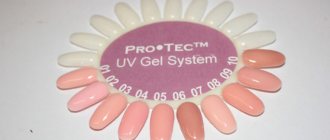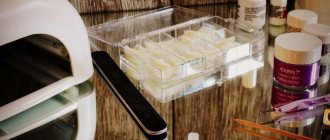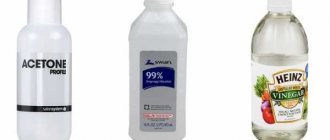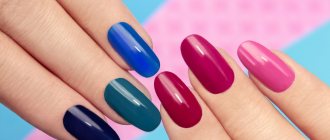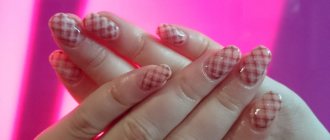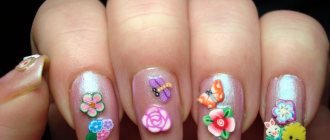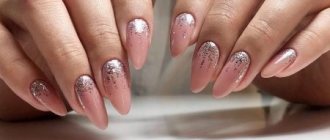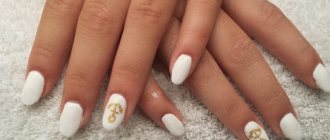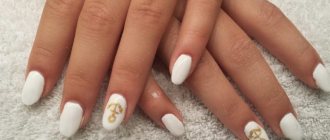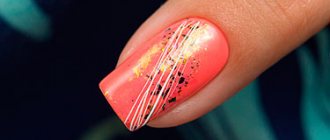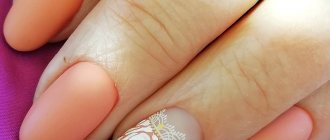New materials for nail services appear today with such frequency that even a true professional sometimes finds it difficult to keep track of all the new products. A beginner can get completely confused.
Single-phase gel for nail extensions has already become quite popular and has acquired an enviable number of fans both among certified specialists and among those who are taking their first steps in understanding the intricacies of this beautiful art. Our article will help you understand all the intricacies of the technology for those who decide to learn how to use single-phase gel for nail extensions, what kind of material it is and what are the features of working with it.
Why is the gel called single-phase?
To find the answer to this question, let's consider the main stages of technology. The extension is carried out in three stages:
- Applying a base coat responsible for adhesion to the surface of the natural nail.
- Shape modeling.
- Coating with a fixing layer that prevents rapid wear of the material and is responsible for the gloss (or for the velvety surface if the design involves a matte texture).
A three-phase system involves the use of three different products, each of which performs a different function. But when it comes to single-phase coating, only one material is needed. What it is? Single-phase gel for nail extensions, of course. He is able to solve all three problems.
Single-phase gel for nail extension is
Single-phase gel is a favorite material among beginners and is included in the list of what is needed for gel nail extensions. You don't have to mess with it for a long time. There is no need to buy several products at once to extend and strengthen the nail plate, and therefore the process is significantly cheaper and simplified. In general, this type of product is good for those who are just getting acquainted with the science of extensions.
This type of product is used in cases where it is necessary to create the simplest possible manicure without the use of special design nuances.
To put it more simply, a single-phase gel is a prefabricated composition designed to:
- Prime;
- Model;
- Fasten.
And this does not mean that applying one layer is enough. It will be necessary to work on the principle of a three-phase set, that is, apply in three layers, but at the same time keep in mind the features of the product. The main disadvantage of this gel is its rather liquid, spreading consistency. Accordingly, it is not entirely convenient for her to create the apex zone, seal the ends, and shape the nail in general. Therefore, when using this composition, you will need to make certain tricks.
To properly design the apex and ends, after application, you need to turn the nail over with the front part facing the working surface so that, under the force of gravity, the gel flows into the desired areas. You need to hold it for a few seconds, then stretch the gel with a brush to the free edge, turn your hand over to its normal position and dry it in the lamp.
But how good Evelyn 8 in 1 nail polish is when used, you can find out here.
Despite the fact that professionals themselves do not use this type of product, they all say that if you begin to get acquainted with such a process as nail extensions, then you cannot find a better option for use. Having gone through all the difficulties with it, having learned to work with such a product, it will then be much easier to master other options for gel-based drugs.
The product is inherently ergonomic and perfectly combines base, foundation and top. Often such compositions are used on clients in salons if they have allergies or simply increased sensitivity of their nails and skin. This is explained by the fact that the composition does not contain toxic aggressive substances that are present in more “powerful” professional preparations. And the application makes such a composition easier, since most often it does not require applying the composition in several layers. And the nails themselves will look more natural. But in what case it is worth using hard nail polish, it is detailed here.
The video shows the entire nail extension procedure:
Material advantages
Often, a single-phase gel becomes the choice of beginners. This is the right decision, because you will have to spend money on just one jar to start getting better at extensions.
Another advantage is the consistency of the material. Compared to three-phase products, it is quite liquid, but not flowing. The gel is convenient to apply and distribute.
Many girls who have tried this type of material claim that it is very obedient, can be easily crimped and can be easily filed. This means that this gel is also suitable for complex arched shapes, such as a pipe.
For many who decided to find out what it is - single-phase gel for nail extensions, the discovery was the huge selection of colors. Manufacturers offer not only classic white, pink and transparent gels, but also a whole palette of camouflages, as well as luxurious opal options, gels with shimmer and sparkles, and luminescent materials. In the palettes of many brands you can easily find gel of any color.
It’s not difficult to understand how to use single-phase gel for nail extensions. If you have experience working with three-phase materials, you will probably enjoy the process. But even if this is your first attempt, you can count on a good result.
However, you should not be deceived and wait for a miracle. Working with any materials for gel manicure has many nuances. If you have the desire and opportunity to take a training course, be sure to do so. Well, if this is not possible (or you even consider nail extensions as a hobby), get ready for hard work. Follow our advice, perform each operation carefully, train and study - then everything will definitely work out.
Which company to choose for home use
Professional and home use require a different approach to the selection of materials. Using high-quality and proven products significantly increases the guarantee of a good result, but this can negatively affect the overall cost of the transformation. To comprehensively consider the issue of purchasing a suitable gel, it is enough to familiarize yourself with the main nuances of using various materials.
Key points when choosing a gel for extensions:
- The consistency of the product should be sufficiently viscous, but not too thick, so that application is problem-free.
- When purchasing several products, it is advisable to choose products from only one manufacturer so that the materials are harmoniously combined with each other in composition.
- To polymerize the coating, you must also use a special ultraviolet lamp to dry your nails. There are gels that do not require such equipment, but the durability of this option is slightly worse.
- For a particular type of work, it is advisable to purchase appropriate materials. There are special categories for creating French manicure, French manicure and shellac. Using materials as intended will allow you to achieve better results.
- Even the smell of the product matters. Too strong a chemical trace is left by harmful compounds that are prohibited in most countries. Modern formulations use more gentle substances, so it is better to leave the right of choice to them.
You also need to pay attention to the composition of the nail polish. The market for such goods is constantly updated, so many offers will become irrelevant over time. By keeping up with new products and promptly replenishing stocks of such products, you will be confident in the quality of the coating performed.
What you need for gel nail extensions: you will find a list of materials in this material.
Watch a video review of gels
Necessary tools and aids
Apply the single-phase gel using a flat brush with a rounded end made of synthetic bristles. Natural is not suitable for these purposes. When choosing a brush, place it on the nail of your little finger and press lightly: it should not go into the side rollers.
To dry gels, it is best to use hybrid lamps with a power of at least 36 watts.
You can’t do without forms, lint-free napkins and a cleaner. The most important tool after a brush, perhaps, can be considered a file with an abrasiveness of 100\180 grit. Some craftsmen use a machine with a suitable cutter for sawing, but this requires considerable skill.
Preparing the nail plate
If the material comes into contact with the pterygium, cuticle or skin, detachments cannot be avoided. Therefore, the preparatory stage is extremely important. There are no special recommendations when working with single-phase gel: do your manicure in the same way as you would before working with any other material.
Thoroughly clean the nail from the pterygium, move it back, cut and polish the cuticle with a ball-shaped cutter, and treat the areas adjacent to the side ridges. File the ends with a file with an abrasiveness of 180 grit. Polish the surface of the nail plates with a buff, carefully remove dust, wipe the nails with a lint-free cloth soaked in a special cleaner.
Experts do not recommend using pharmaceutical products with alcohol. This component is quite aggressive: it can dry out the skin or react with materials, which will complicate the work and ruin the result.
What does single-phase gel polish mean?
Every woman is well aware of how difficult it is to perform a modern manicure. It is necessary to perform the usual cleaning of the cuticles and give the desired shape to the nails. Then cover the plate several times with various bases, varnishes, fixatives and keep it under the lamp. With the advent of single-phase varnishes, doing a modern manicure has become much easier. It is enough to apply it in one or two layers.
Single-phase varnishes have a unique formula and do not pose a health hazard. The composition includes several components at the same time, 3 in 1:
- the basis;
- pigment;
- fixative
The colors are saturated, the consistency is right, one layer is enough to get an even coating of the plate. This not only reduces time costs, but also allows you to significantly save on visiting a nail salon. Single-phase gel polish has a number of other positive aspects:
- now the art of modern manicure is available to every woman;
- The product is applied once and does not interfere with air access to the nail plate;
- lasts a long time;
- time is saved;
- can be combined with single-phase gel polish, any coating can be used.
They appeared on the shelves not long ago, but instantly gained popularity.
What is the difference between a single-phase gel and a three-phase one?
Single-phase gel polish consists of three components contained in one bottle. Three-phase - individual components contained in three vials:
- base coat;
- pigment or color coating;
- fixative
The base acts as a kind of adhesive tape, as it does not dry out completely and remains sticky. The color is applied on top, which must be secured with a topcoat or sealer. The last layer can be glossy, matte and has a characteristic odor that persists for some time after application.
What is the difference between a single-phase gel and a two-phase one?
It is easy to understand now that the two-phase gel is contained in two vials.
- Base or base coat.
- Color coating with fixative.
The process does not require much time. Before application, preliminary grinding of the plate and polishing of each layer with a special cloth is required.
Primer: why you need it, which one to choose, how to use it
Some masters consider this stage optional. But if there are no obstacles (for example, allergies), it is better to use a primer. It acts like double-sided tape, reliably adhering the material to the surface of the nail.
The primer also solves other problems: eliminates excess moisture, prevents the development of infections, degreases, and slightly dries the surface.
There are so-called acidic and acid-free products. In fact, both contain acids, but in the second their content is lower. This option is suitable for treating nails before applying polish.
And before applying single-phase extension gel, nails must be coated with an acid primer. It is important that the material does not come into contact with the skin. The product dries in air, it does not need a lamp. You can begin further stages of coating in a minute. But if more than half an hour has passed since applying the primer, the procedure must be repeated. Therefore, there is no point in covering all 10 nails before starting work.
How to apply single-phase gel polish
The procedure begins with regular nail cleaning, which is familiar to all women. It is necessary to remove the old polish, steam the cuticle, trim it and give the nail plate the desired shape using a nail file. You can treat the plate with a buff, this will ensure stronger adhesion of the varnish to the nail. Then proceed step by step:
- treat the plate with a degreaser;
- dry, apply varnish;
- Dry the first layer under a lamp;
- Apply a second coat and dry again.
Durable, bright and juicy coating. The perfect manicure at home is ready. The whole procedure takes no more than 15 minutes.
Review of popular products
Which single-phase gel for nail extension is better? There is no definite answer to this question; each master has his own favorites. But we can highlight several products, the reviews of which are the most numerous.
- RuNail can be called one of the most popular. Available in several shades, it files and presses well, and is well suited for beginners. Course teachers often choose this material: nail extensions with RuNail single-phase gel are discussed step by step during training. It is suitable for professionals with a lot of traffic, and for those who only do their own nails. Low cost is one of the advantages of the product. A jar of 15 grams will cost on average 250-300 rubles.
- Formula Profi is a brand loved by many craftsmen. For a jar of single-phase gel “A-Profi” you will have to pay about 450 rubles. Once polymerized, the gel turns into a very durable monolith. It is easy to file and does not create a large amount of flying dust.
- UV Lina is a product that many craftsmen who are passionate about shopping on Chinese sites have become familiar with. The cost of one jar weighing 15 g is only about 100 rubles. Reviews about this product are extremely contradictory. Some claim that the single-phase gel for nail extension “Lina” copes with the tasks perfectly. But there are also those who warn potential buyers against the terrible smell, poor packaging, and allergic reactions.
- Cosmoprofi gel is available in several shades. It is loved by manicurists due to its comfortable consistency of medium viscosity, average price (350 rubles / 15 g), and good wearability.
- Irisk single-phase gels are praised by many for their lack of odor and large palette of shades. But in reviews, some note a runny texture, due to which the material tends to flow. Not everyone is happy that the time stated by the manufacturer is not enough for polymerization.
Extensions at home
When working at home, you need to carefully select a gel. When using the three-phase method, it is necessary that the gel of the second phase has a dense texture; it should not spread under any circumstances. You need to choose simple tips; they can be used to create a French manicure. Gradually you can add more complex options to your arsenal. There are different forms for manicure:
- Intended for one-time use.
- Reusable.
The advantage of disposable forms is their low price. They are made of plastic or paper. In order to get excellent results when doing nail extensions at home, you need to understand what good gel for nail extensions professionals recommend using at home. You need to be guided by the following criteria:
- For use at home, it is better to take a gel that hardens using a device such as a UV lamp. Such products are easy to apply and do not have a pronounced, pungent odor.
- It is important to choose non-viscous gels. If it has a too thick structure, modeling the nail will be difficult. The product with a very liquid texture spreads and is prone to cracking.
- The product must have a certificate confirming its quality. This product is safe and will not cause disappointment or unpleasant consequences.
Poor quality material is harmful. Because unscrupulous manufacturers add various substances to products of poor quality that are harmful to nails and negatively affect health in general. After using such materials, nails often require long and serious treatment. Therefore, you need to choose trusted manufacturers, and fall for advertising tricks, which are often used by dubious little-known companies.
For the best combination with three-phase extension, you need to choose products from the same company. They contain approximately the same components and are best suited to each other.
Gel nail coating involves three stages. The first is designed to level the surface of the nail and ensure adhesion of the base material to it. At the second stage, the nail is modeled using gel. At the final third stage, a finishing coating is applied, which provides a mirror-like shine and strength.
Gels that combine all three stages are called single-phase. They are more economical and easy to work with, especially for beginners.
There are also two- and three-phase gels. In them, a certain drug is responsible for each stage. It’s easy to guess that in a two-phase gel there are two such preparations, and a three-phase gel for nail extensions consists, respectively, of three. Such gels are more expensive, more difficult to work with, and the duration of the procedure increases.
When buying a gel, you should find out how it hardens.
- The most common are photosensitive gels, which are polymerized using an ultraviolet lamp.
- There are also gels that harden with the help of a catalyst. This is a special substance that, when reacting with the gel, promotes its hardening. However, it is worth considering that these gels are viscous and quite difficult to work with.
When choosing which gel is best for nail extensions, you should pay attention to colored analogues. They are indispensable for nail design and creating a fashionable, bright, multi-colored manicure. Of course, after a few days the regrown part of the nail will be noticeable. But this can be dealt with using regular varnish to match the gel. The entire nail and its regrown part are covered with varnish, thereby refreshing the appearance of the nails.
Extension on forms
Let’s make a reservation right away that this material is not suitable for the top forms that are fashionable today. Only classic lower forms can be used.
There's no need to rush. If you have little experience yet, work with each finger separately, drying each layer. Before you start using single-phase extension gel, nails should be thoroughly treated, degreased and coated with primer.
- Adjust the shape to the nail, making cuts if necessary so that the base fits as tightly as possible.
- Carefully glue the edges together, making sure that all symmetrical elements match completely. You can use a stationery stapler to prevent the form from coming unglued while working.
- Using rubbing movements, apply the first base layer of single-phase gel, starting from the end and moving towards the cuticle. Avoid contact with skin! If the gel is baked on the cuticle, detachments are inevitable.
- Cure the material in the lamp for as long as the manufacturer recommends. Evaluate the result by lightly tapping the surface with a pusher.
- Place a drop of gel on the mold, where the free edge will form. Use confident strokes to distribute the material, following the markings. Shape the apex depending on the desired length. Place in a lamp to dry.
- Carefully evaluate the surface, if necessary, add a little gel to the gaps. File off unnecessary bulges with a file. If you don't plan on doing the design, simply cover the nail with another thin layer of gel, turn your hand over, palm down, and let the material level out. Send the work back to the lamp.
- You can start sawing. Follow the direction of the side edges, check the symmetry of the nail. Single-phase gel does not need a topcoat, but you can use, for example, a satin or velor finish for decorative purposes.
- All that remains is to remove the dust and remove the stickiness with a special product.
How to remove single-phase gel polish from nails
To remove single-phase gel polish, you will need a liquid used to dissolve such products or a simple remover for ordinary nail polish.
- Apply the product to a cotton pad.
- Do not rub the plate, but simply wrap it with a moistened disc.
- Cover each finger with foil or film. This is necessary to limit air access to the plate.
- The instructions for the liquid indicate the time that must be followed. This is exactly how long you will need to keep a kind of compress on your nails.
- When using nail polish removers that contain acetone, the time will increase. You need to keep it for about 15 minutes.
- Remove the compress from your finger, test the coating layer for strength using a stick. If it has softened enough, it will come off easily. If not, you need to return the compress to its place.
After the coating is removed from the nail, do not rush to apply a new one. You need to cover the plates with nourishing oil, let them rest a little, and breathe. If something is not entirely clear, you can look at the instructions.
Polymerization time
Always pay close attention to the manufacturer's recommendations if you have purchased a new single-phase nail extension gel. How to use the material, how long to dry the layers and other recommendations - all this is usually indicated on the packaging. On average, it takes 1-3 minutes to dry the gel in a hybrid lamp for each layer.
Recommendations for strengthening nails with gel
There are no contraindications for using the strengthening gel, but before the procedure you need to get rid of nail diseases, if any. The proteins that make up the gel nourish the nail plates, and the product itself is neutral in impact.
You need to carefully use the lamp to dry the gel coating.
The main precaution may be to use the lamp in moderation . The drying time and temperature must be correct, otherwise the gel will not harden or will simply boil, and your fingers will get burned.
Gel coating will help your nails grow and make them stronger. Strengthening with gel will also help get rid of flaking and brittleness. This coating protects nails of any length from damage and gives your hands a well-groomed appearance.
Why does the gel bake in the lamp?
In reviews of single-phase nail extension gels, you can often find indignation about burning during drying. This occurs due to the fact that the material passes from one state of aggregation to another, crystal lattices are formed. Chemical processes are accompanied by the release of heat.
It is enough to simply reduce the lamp power (if this function is provided by the equipment manufacturer). When working with unregulated lamps, you can simply remove your hand for a few seconds, allowing the heated material to cool slightly. As soon as the gel “sets”, the burning sensation will go away.
It should be understood that this is not a lack of material, but a technological feature.
Types of materials
The materials used are divided into several types:
- Single-phase: the procedure is carried out using one gel. The product performs all three main tasks: adhesion, modeling and fixing the nail. Working with single-phase material is much easier. The price of the material is relatively high, but it is justified by the ease of use.
- Two-phase: in this case, two materials are needed. The first product is a modeling base. It is necessary in order to provide traction. The design owes its strength to the second means. In the second phase, sculpting gels are used. They come in transparent or camouflage. Camouflage products have the same color as natural claws. A clear gel is used to ensure the desired shape and length. To harden the nail, you can use a UV lamp or LED device.
- Three-phase: this method requires three gels. The first is a modeling base, the second maintains strength, the third provides grip. Three-phase extension requires a lot of time and a lot of experience. This method, in addition to skill, also requires high costs, since the cost of the material is higher compared to the first two materials.
Common questions and answers
Most often, beginners wonder whether it is possible to use products of a three-phase system as a single-phase gel. Unfortunately this is not possible. But a single-phase one is suitable instead of a modeling or finishing coating.
It is highly undesirable to use this material for French lay-outs. In any case, you will need at least two gels of different colors, so what is the point of using a single-phase one? It is much easier to use a three-phase system.
Doubts are often raised about the possibility of using a single-phase gel to strengthen nails without extensions. The material is excellent for these purposes. It can be used as a base for gel polish and for repairing broken nails.
Which brand of single-phase gel should I use?
Single-phase is used as a strengthening agent for the natural nail plate. A characteristic feature of this product is that it can be used at all stages of extension: base, modeling and finishing coat.
Working with this gel is very simple and fast. But the single-phase one costs much more than the others. But here we cannot say so clearly, because when you buy one gel, you will not need to spend money on purchasing other materials for modeling and finishing coating.
Why nail polish does not dry on nails can be found in this article.
What reviews there are about Colorama nail polish, the content of this article will help you understand.
What is the rating of the most durable nail polish that currently exists, you can find out from this article here: https://soinpeau.ru/kosmetika/dekorativnaya/lak/kakoj-lak-nogtej-samyj-stojkij.html
